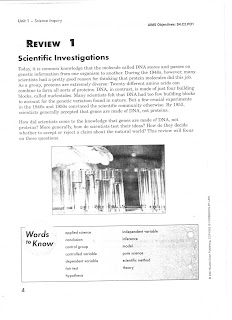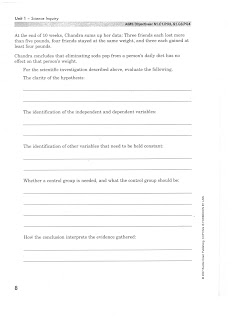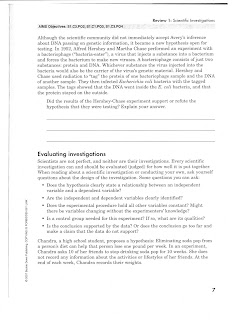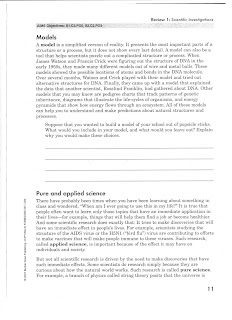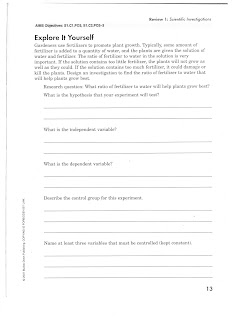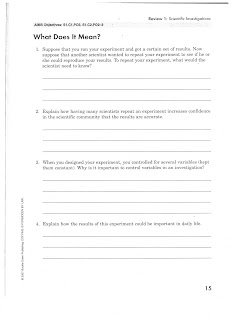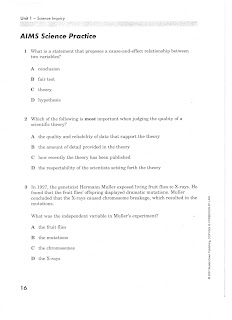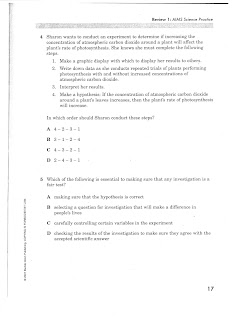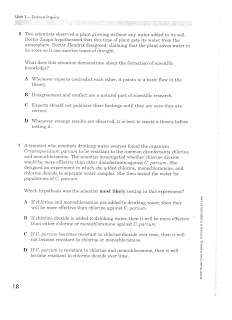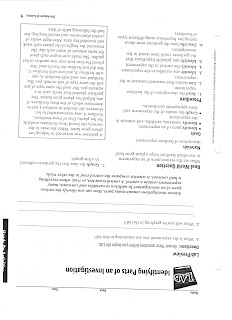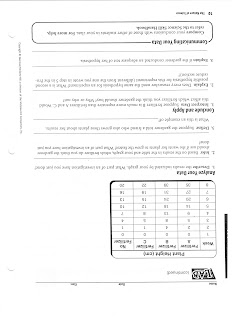Saturday, September 25, 2010
Ms. Friedman
Biology
Week_____9/27/10 -10/1 10_______________________________________________________________
Day of the Week
Teacher Objective
Activity
AZ Science Standards
Performance Objectives
Student Activity
Classwork
Assignment
Monday -finish,and submit
Designing a Lab #1
-continue work on AIMS
review #1
1/1/PO 1-4
1/2/PO 1-5
1/3/PO1-2 -use scientific method to analyze data and draw a conclusion
-analyze scientific case studies to evaluate the reliability, or lack of, in scientific studies -study notes
-finish lab report; due: Tues 9/ 28
Tuesday -finish work on AIMS review #1
-go over AIMS review #1 1/1/PO 1-4
1/3/PO 1-7 -use text and whole group analysis of research studies to evaluate the reliability of research reports -study notes
Wednesday -go over AIMS review #1 1/1/PO 1-4
1/3/PO 1-7 -use text and whole group analysis of research studies to evaluate the reliability of research reports -study notes
Thursday -go over AIMS review #1 1/1/PO 1-4
1/3/PO 1-7 -use text and whole group analysis of research studies to evaluate the reliability of research reports -study notes
-Aims review due: Fri, 10/1
Friday teaching/discussion:
validity/reliability tests of research 1/3/PO 2-4 -read research reports
-evaluate how research met, or did not meet, research protocols -study notes
Weekly Plans-Foundation in Science -9/27-10/1/10
Ms. Friedman
Foundations in Science
Week_____9/27/10 -10/1 10_______________________________________________________________
Day of the Week
Teacher Objective
Activity
AZ Science Standards
Performance Objectives
Student Activity
Classwork
Assignment
Monday -Per. 6 – quiz on scientific method
-lab- work through research designed last week to utilize the scientific method to answer the question: “Which cleanser is best in eliminating bacteria?” 1/1/PO 1-4
1/2/PO 1-5
1/3/PO1-2 -students take quiz on scientific method-Per. 6
-students carry through research design and formulate and analyze data and draw conclusions -finish lab report:
due Tues, 9/28
Tuesday -finish worksheets-“ Scientific Method and “Identifying Parts of an Investigation”
-introduce, explain readings in AIMS Review #1 1/1/PO 1-4
1/3/PO 1-7 -students use notes to -finish worksheets
-questions by instructor and students to gain understanding
-whole group work -study notes
Wednesday
-continue work on AIMS Review # 1
-provide workbooks; short answers on separate paper 1/1/PO 1-4
1/3/PO 1-7 --questions by instructor and students to gain understanding
-whole group work -study notes
Thursday
-continue work on AIMS Review # 1
-provide workbooks; short answers on separate paper 1/1/PO 1-4
1/3/PO 1-7 --questions by instructor and students to gain understanding
-whole group work -study notes
Friday teaching/discussion:
validity/reliability tests of research 1/3/PO 2-4 -read research reports
-evaluate how research met, or did not meet, research protocols -study notes
Weekly Plans-9/27/10 to 10/1/10
Ms. Friedman
Biology
Week_____9/27/10 -10/1 10_______________________________________________________________
Day of the Week
Teacher Objective
Activity
AZ Science Standards
Performance Objectives
Student Activity
Classwork
Assignment
Monday -finish,and submit
Designing a Lab #1
-continue work on AIMS
review #1
1/1/PO 1-4
1/2/PO 1-5
1/3/PO1-2 -use scientific method to analyze data and draw a conclusion
-analyze scientific case studies to evaluate the reliability, or lack of, in scientific studies -study notes
-finish lab report; due: Tues 9/ 28
Tuesday -finish work on AIMS review #1
-go over AIMS review #1 1/1/PO 1-4
1/3/PO 1-7 -use text and whole group analysis of research studies to evaluate the reliability of research reports -study notes
Wednesday -go over AIMS review #1 1/1/PO 1-4
1/3/PO 1-7 -use text and whole group analysis of research studies to evaluate the reliability of research reports -study notes
Thursday -go over AIMS review #1 1/1/PO 1-4
1/3/PO 1-7 -use text and whole group analysis of research studies to evaluate the reliability of research reports -study notes
-Aims review due: Fri, 10/1
Friday teaching/discussion:
validity/reliability tests of research 1/3/PO 2-4 -read research reports
-evaluate how research met, or did not meet, research protocols -study notes
Thursday, September 23, 2010
Wednesday, September 22, 2010
Friday, September 17, 2010
Note: This is a plan we hope to follow. If students have problems with the material, and re-teaching is indicated, this schedule may not be met as indicated here.
Mon, 9/20/10 - Tues, 9/21/10:
-students will finish the worksheet "Identifying Parts of an Investigation"
-students will take a quiz on the Scientific Method, based on the notes the were provided
-notetaking on- direct and inverse relationships within data analysis
data analysis methods - mean, median, mode
fact, theory, law
Wed, 9/22/10 - Thurs, 9/23/10:
-students will work on "Buckle Down: AIMS Prep Workbook - pgs. 4-18
readings and questions will be done in pairs
-work will be due at the end of class on Thurs, 9/23/10
Fri, 9/24/10:
-Students will be presented with the laboratory question "Which cleanser removes bacteria more thoroughly during hand washing? Is it soap and water or a hand sanitizer?
-Students will design and carry out a research protocol to find the answer to this question.
-Lab report due Mon., 9/27/10
Tuesday, September 14, 2010
Mon 9/13 - Tues 9/14:
- Get all beginning of the year handouts and place in the "Handouts" tab divider of your Biology 3-ring binder. Keep these handouts all year. Your notebook will be graded every quarter and these handouts must be there!
-Begin and finish Biology pretest.
REMEMBER! ALL papers handed in must be labeled with student ID and NOT with student name!
-Assignment: Tues, 9/14/10 - due: Wed, 9/15/10
outline chap. 1, Section 1 in text:
label the names of all the subheadings and list, in short answers, 3 facts for each subheading--
Assignment: Wed, 9/15/10 - due: Thurs, 9/16/10
outline chap. 1, Section 2 in text:
label the names of all the subheadings and list, in short answers, 3 facts for each subheading
Assignment: Thurs, 9/16/10 - due:Fri, 9/17/10
outline chap. 1, Section 3 in text:
label the names of all the subheadings and list, in short answers, 3 facts for each subheading
-Wed 9/15 - Thurs 9/16
-class work - notetaking on scientific method
-Fri 9/17 -
Classwork: Worksheets on "The Scientific Method" and Identifying the Parts of an Investigation". For the 2nd worksheet, do only the back side of the worksheet. Papers due at the end of class.
Ms. Friedman
Biology Course Outline
Inquiry/Scientific Method
Graphing Review
Metric System Review
Biological Principles
Chemistry
Biochemistry
Cells
Structure/Function
Transport Mechanisms
Mitosis
Heredity
Genes/Chromosomes
DNA/RNA
DNA Replication
Genotypes/Phenotypes
Meiosis
Ecology
Populations to Biomes
Biotic/Abiotic Environmental Factors
Population Size/Growth Rate
Biological Evolution
Natural Selection/Speciation
Adaptations
Evidence to Support Organic Evolution
Matter/Energy/Organization in Living Systems
Photosynthesis/Respiration
Biogeochemical Cycles in Ecosystems
Levels of Organization in Living Things
PURPOSE
Science is a hands-on laboratory class. You
will be doing many laboratory activities
which require the use of hazardous
chemicals. Safety in the science classroom is
the #1 priority for students, teachers, and
parents. To ensure a safe science classroom,
a list of rules has been developed and pro-
vided to you in this student safety contract.
These rules must be followed at all times.
Two copies of the contract are provided. One
copy must be signed by both you and a par-
ent or guardian before you can participate in
the laboratory. The second copy is to be kept
in your science notebook as a constant
reminder of the safety rules.
GENERALRULES
1. Conduct yourself in a responsible man-
ner at all times in the laboratory.
2. Follow all written and verbal instruc-
tions carefully. If you do not understand
a direction or part of a procedure, ask the
instructor before proceeding.
3. Never work alone. No student may work
in the laboratory without an instructor
present.
4. When first entering a science room, do
not touch any equipment, chemicals, or
other materials in the laboratory area
until you are instructed to do so.
5. Do not eat food, drink beverages, or
chew gum in the laboratory. Do not use
laboratory glassware as containers for
food or beverages.
6. Perform only those experiments autho-
rized by the instructor. Never do any-
thing in the laboratory that is not called
for in the laboratory procedures or by
your instructor. Carefully follow all
instructions, both written and oral.
Unauthorized experiments are prohib-
ited.
7. Be prepared for your work in the labora-
tory. Read all procedures thoroughly
before entering the laboratory.
8. Never fool around in the laboratory.
Horseplay, practical jokes, and pranks
are dangerous and prohibited.
9. Observe good housekeeping practices.
Work areas should be kept clean and tidy
at all times. Bring only your laboratory
instructions, worksheets, and/or reports
to the work area. Other materials (books,
purses, backpacks, etc.) should be stored
in the classroom area.
10. Keep aisles clear. Push your chair under
the desk when not in use.
11. Know the locations and operating proce-
dures of all safety equipment including
the first aid kit, eyewash station, safety
shower, fire extinguisher, and fire blan-
ket. Know where the fire alarm and the
exits are located.
12. Always work in a well-ventilated area.
Use the fume hood when working with
volatile substances or poisonous vapors.
Never place your head into the fume hood.
13. Be alert and proceed with caution at all
times in the laboratory. Notify the
instructor immediately of any unsafe
conditions you observe.
14. Dispose of all chemical waste properly.
Never mix chemicals in sink drains.
Sinks are to be used only for water and
those solutions designated by the
instructor. Solid chemicals, metals,
matches, filter paper, and all other insol-
uble materials are to be disposed of in
the proper waste containers, not in the
sink. Check the label of all waste con-
tainers twice before adding your chemi-
cal waste to the container.
15. Labels and equipment instructions must
be read carefully before use. Set up and
use the prescribed apparatus as directed
in the laboratory instructions or by your
instructor.
16. Keep hands away from face, eyes,
mouth and body while using chemicals
or preserved specimens. Wash your
hands with soap and water after per-
forming all experiments. Clean all work
surfaces and apparatus at the end of the
experiment. Return all equipment clean
and in working order to the proper stor-
age area.
17. Experiments must be personally moni-
tored at all times. You will be assigned a
laboratory station at which to work. Do
not wander around the room, distract
other students, or interfere with the labo-
ratory experiments of others.
18. Students are never permitted in the
science storage rooms or preparation
areas unless given specific permission
by their instructor.
19. Know what to do if there is a fire drill
during a laboratory period; containers
must be closed, gas valves turned off,
fume hoods turned off, and any electri-
cal equipment turned off.
20. Handle all living organisms used in a
laboratory activity in a humane manner.
Preserved biological materials are to be
treated with respect and disposed of
properly.
21. When using knives and other sharp
instruments, always carry with tips and
points pointing down and away. Always
cut away from your body. Never try to
catch falling sharp instruments. Grasp
sharp instruments only by the handles.
22. If you have a medical condition (e.g.,
allergies, pregnancy, etc.), check with
your physician prior to working in lab.
CLOTHING
23. Any time chemicals, heat, or glassware
are used, students will wear laboratory
goggles. There will be no exceptions to
this rule!
24. Contact lenses should not be worn in the
laboratory unless you have permission
from your instructor.
25. Dress properly during a laboratory activ-
ity. Long hair, dangling jewelry, and
loose or baggy clothing are a hazard in
the laboratory. Long hair must be tied
back and dangling jewelry and loose or
baggy clothing must be secured. Shoes
must completely cover the foot. No san-
dals allowed.
26. Lab aprons have been provided for your
use and should be worn during labora-
tory activities.
ACCIDENTS AND INJURIES
27. Report any accident (spill, breakage,
etc.) or injury (cut, burn, etc.) to the
instructor immediately, no matter how
trivial it may appear.
28. If you or your lab partner are hurt,
immediately yell out “Code one, Code
one” to get the instructor’s attention.
29. If a chemical splashes in your eye(s) or
on your skin, immediately flush with
running water from the eyewash station
or safety shower for at least 20 minutes.
Notify the instructor immediately.
30. When mercury thermometers are bro-
ken, mercury must not be touched.
Notify the instructor immediately.
HANDLING CHEMICALS
31. All chemicals in the laboratory are to be
considered dangerous. Do not touch,
taste, or smell any chemicals unless
specifically instructed to do so. The
proper technique for smelling chemical
fumes will be demonstrated to you.
32. Check the label on chemical bottles
twice before removing any of the con-
tents. Take only as much chemical as
you need.
33. Never return unused chemicals to their
original containers.
Flinn Scientific’s Student Safety Contract
© 2004, Flinn Scientific, Inc. All Rights Reserved. Reproduction permission is granted to science teachers who are customers of Flinn Scientific, Inc. Batavia, Illinois, U.S.A. No part of this material may be reproduced or trans-
mitted in any form or by any means, electronic or mechanical, including, but not limited to photocopy, recording, or any information storage and retrieval system, without permission in writing from Flinn Scientific, Inc.
P.O. Box 219, Batavia, IL60510
1-800-452-1261 • Fax: (866) 452-1436
flinn@flinnsci.com • www.flinnsci.com
“Your Safer Source
for Science Supplies”
34. Never use mouth suction to fill a pipet.
Use a rubber bulb or pipet pump.
35. When transferring reagents from one
container to another, hold the containers
away from your body.
36. Acids must be handled with extreme
care. You will be shown the proper
method for diluting strong acids. Always
add acid to water, swirl or stir the solu-
tion and be careful of the heat produced,
particularly with sulfuric acid.
37. Handle flammable hazardous liquids over
a pan to contain spills. Never dispense
flammable liquids anywhere near an open
flame or source of heat.
38. Never remove chemicals or other materi-
als from the laboratory area.
39. Take great care when transporting acids
and other chemicals from one part of the
laboratory to another. Hold them
securely and walk carefully.
HANDLING GLASSWARE
AND EQUIPMENT
40. Carry glass tubing, especially long
pieces, in a vertical position to minimize
the likelihood of breakage and injury.
41. Never handle broken glass with your
bare hands. Use a brush and dustpan to
clean up broken glass. Place broken or
waste glassware in the designated glass
disposal container.
42. Inserting and removing glass tubing
from rubber stoppers can be dangerous.
Always lubricate glassware (tubing, this-
tle tubes, thermometers, etc.) before
attempting to insert it in a stopper.
Always protect your hands with towels
or cotton gloves when inserting glass
tubing into, or removing it from, a rub-
ber stopper. If a piece of glassware
becomes “frozen” in a stopper, take it to
your instructor for removal.
43. Fill wash bottles only with distilled
water and use only as intended, e.g., rins-
ing glassware and equipment, or adding
water to a container.
44. When removing an electrical plug from
its socket, grasp the plug, not the electri-
cal cord. Hands must be completely dry
before touching an electrical switch,
plug, or outlet.
45. Examine glassware before each use.
Never use chipped or cracked glassware.
Never use dirty glassware.
46. Report damaged electrical equipment
immediately. Look for things such as
frayed cords, exposed wires, and loose
connections. Do not use damaged elec-
trical equipment.
47. If you do not understand how to use a
piece of equipment, ask the instructor for
help.
48. Do not immerse hot glassware in cold
water; it may shatter.
HEATING SUBSTANCES
49. Exercise extreme caution when using a
gas burner. Take care that hair, clothing
and hands are a safe distance from the
flame at all times. Do not put any sub-
stance into the flame unless specifically
instructed to do so. Never reach over an
exposed flame. Light gas (or alcohol)
burners only as instructed by the teacher.
50. Never leave a lit burner unattended.
Never leave anything that is being
heated or is visibly reacting unattended.
Always turn the burner or hot plate off
when not in use.
51. You will be instructed in the proper
method of heating and boiling liquids in
test tubes. Do not point the open end of
a test tube being heated at yourself or
anyone else.
52. Heated metals and glass remain very
hot for a long time. They should be set
aside to cool and picked up with cau-
tion. Use tongs or heat-protective
gloves if necessary.
53. Never look into a container that is being
heated.
54. Do not place hot apparatus directly on
the laboratory desk. Always use an insu-
lating pad. Allow plenty of time for hot
apparatus to cool before touching it.
55. When bending glass, allow time for the
glass to cool before further handling. Hot
and cold glass have the same visual
appearance. Determine if an object is hot
by bringing the back of your hand close
to it prior to grasping it.
QUESTIONS
56. Do you wear contact lenses?
YES NO
57. Are you color blind?
YES NO
58. Do you have allergies?
YES NO
If so, list specific allergies___________
________________________________
________________________________
Flinn Scientific’s Student Safety Contract
AGREEMENT
I, ___________________________,
(student’s name) have read and agree
to follow all of the safety rules set
forth in this contract. I realize that I
must obey these rules to ensure my
own safety, and that of my fellow stu-
dents and instructors. I will cooperate
to the fullest extent with my instructor
and fellow students to maintain a safe
lab environment. I will also closely
follow the oral and written instructions
provided by the instructor. I am aware
that any violation of this safety con-
tract that results in unsafe conduct in
the laboratory or misbehavior on my
part, may result in being removed
from the laboratory, detention, receiv-
ing a failing grade, and/or dismissal
from the course.
Student Signature
Date
Dear Parent or Guardian:
We feel that you should be informed
regarding the school’s effort to create
and maintain a safe science class-
room/laboratory environment.
With the cooperation of the instruc-
tors, parents, and students, a safety
instruction program can eliminate,
prevent, and correct possible hazards.
You should be aware of the safety
instructions your son/daughter will
receive before engaging in any labora-
tory work. Please read the list of safety
rules above. No student will be permit-
ted to perform laboratory activities
unless this contract is signed by both
the student and parent/guardian and is
on file with the teacher.
Your signature on this contract indi-
cates that you have read this Student
Safety Contract, are aware of the mea-
sures taken to ensure the safety of
your son/daughter in the science labo-
ratory, and will instruct your son/
daughter to uphold his/her agreement
to follow these rules and procedures
in the laboratory.
Parent/Guardian Signature
Date
© 2004, Flinn Scientific, Inc. All Rights Reserved. Reproduction permission is granted to science teachers who are customers of Flinn Scientific, Inc. Batavia, Illinois, U.S.A. No part of this material may be reproduced or trans-
mitted in any form or by any means, electronic or mechanical, including, but not limited to photocopy, recording, or any information storage and retrieval system, without permission in writing from Flinn Scientific, Inc.
1. The first order of business is making a study schedule and sticking to it.
2. Next what you need to do is find the proper area to study in. You will want an area that is well lit, quiet, and most importantly NO distractions. Put the T.V, radio, ipod etc. away and get your school books out.
3. Make sure you are sitting at a desk and not lying down. I have done this too many times and fallen asleep then the next thing you know, it's morning and back to school you go unprepared for your exam. Also make sure that your desk has plenty of space on it for all of your books and supplies so you do not have to hunt for that pencil or notebook.
4. As you study try to picture the lesson in your head adding key details as if you are writing the lesson on your own.
Ask your self questions like "What are they trying to tell me?
5. "What is the basic meaning behind that statement?" Make up words to associate with hard to remember names and dates. For example, the colors of the rainbow you probably remember your teacher telling you to remember the name Roy G Biv . Each letter represents a color of the rainbow in order from top to bottom. Red-Orange-Yellow-Green-Blue-Indigo-Violet =Roy G Biv
6. Only study around 50-60 minutes at a time, then take a 15 minute break. I found that if I forced my self to study all the way through, I would end up losing the information that I wanted to remember, and become frazzled.
7. One last tip and this one is the most important of all. Every one of these study techniques or any study guide that you inquire about, is dependent on you and how badly you want to learn and improve your grades. If you do not have the drive to excel, nothing will work for you. You must make the decision to better yourself. As my friends used to tell me--work smart, not hard.
√
Sunday, September 12, 2010
Academy of Tucson High School
Science/Biology
Ms. Friedman
Welcome aboard!
Remember, this is a transition time for you. Please let me help! Make an after school appointment if I can do anything to help enhance your success here at The Academy of Tucson.
Things to Do
-Sign laboratory safety handout, once you've understood it and agree to abide by it's guidelines.
Show signatures to instructor so you will be allowed to do labs.
-Text signout procedures
-sign your name, in ink, in the inside front cover of text
-fill out the "book issuance agreement form" completely
-list all damages to text on "book issuance agreement form"
-any damages not listed will be charged to you at the end of the year
-submit the completed book form to instructor before taking the text out of classroom
-Textbooks must be covered at all times
Materials to Bring to Class Every Day
1.) 3 ring notebook -
Sections in the 3 ring notebook:
Handouts
One section for each topic we study
2.) Textbook
3.) Paper, pens and pencils - BRING EVERY DAY!!!
Course Requirements
-Participation in class
-Read over/study notes - every night
-Homework, Lab Reports, Quizzes, Tests
Grading Policy
A = 90-100
B = 80-89
C = 70=79
D = 60=69
F = below 60
Academy of Tucson High School
